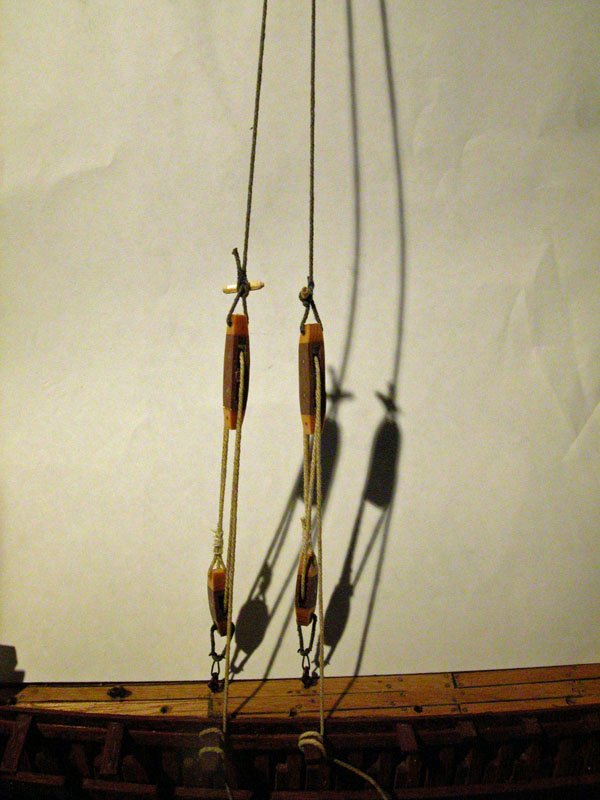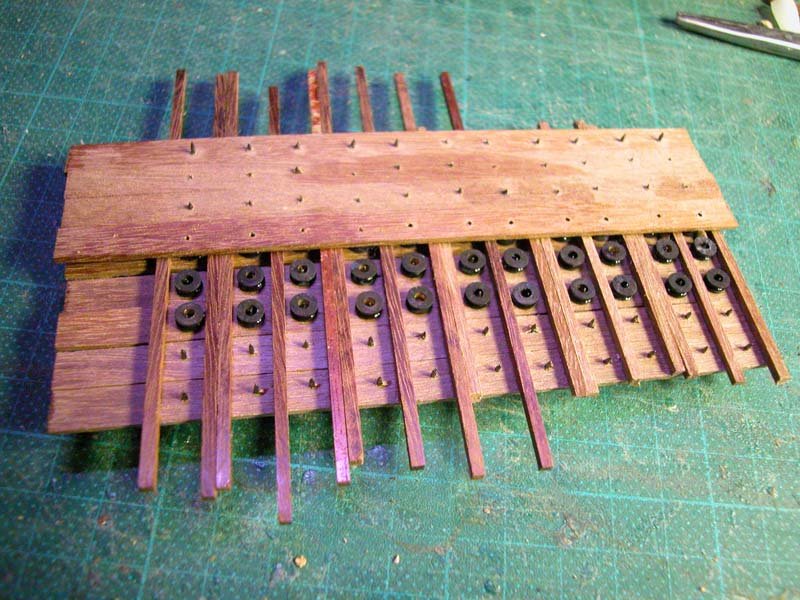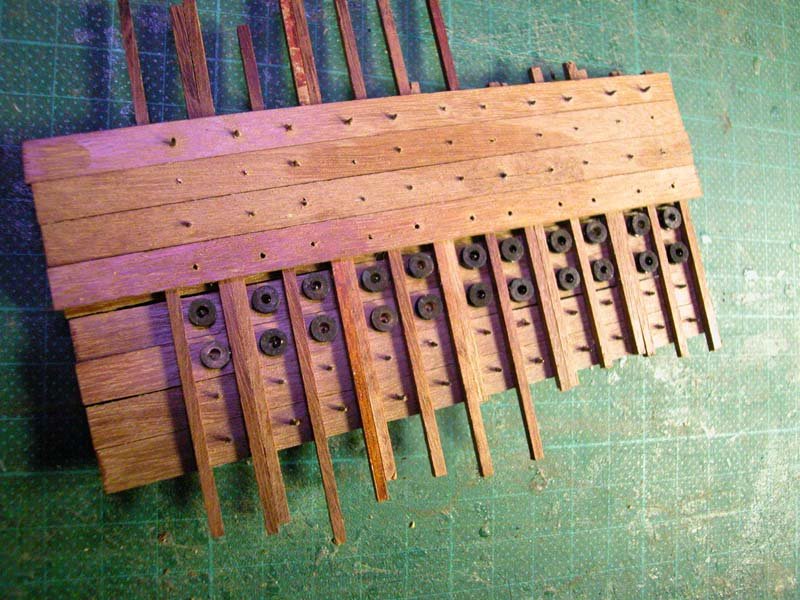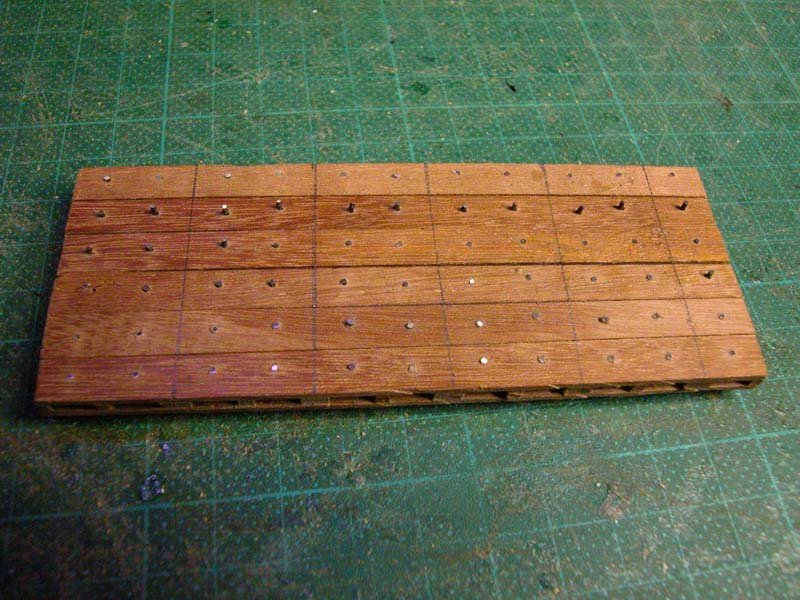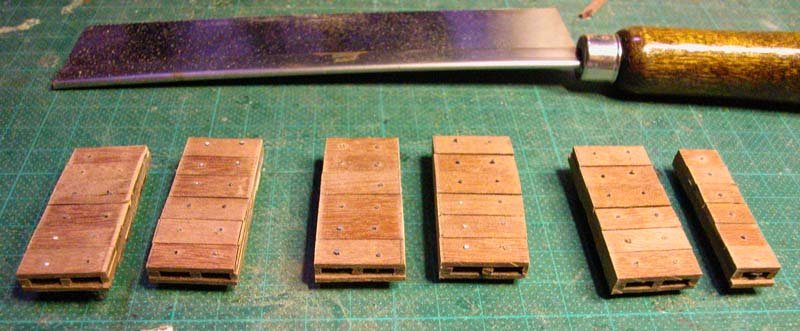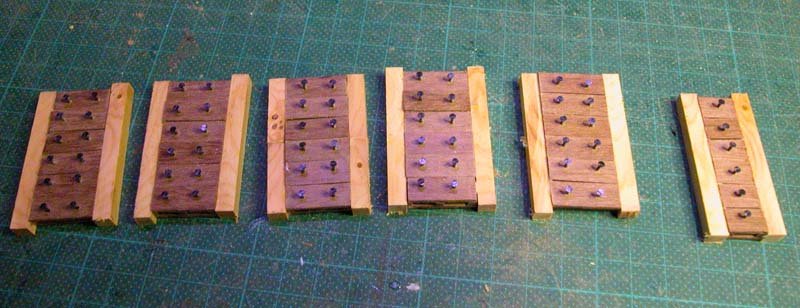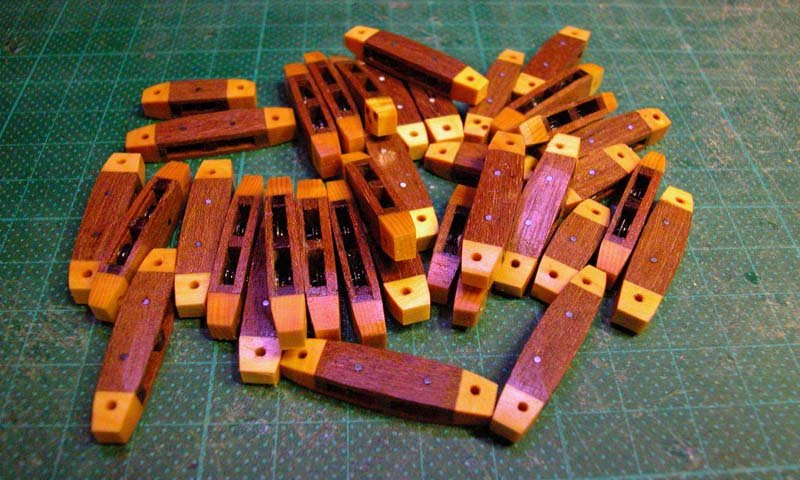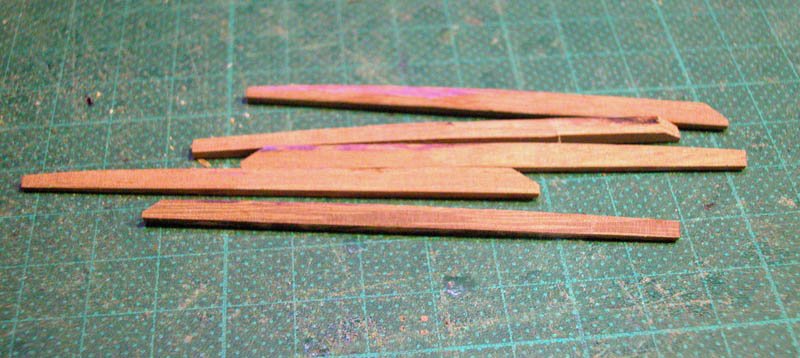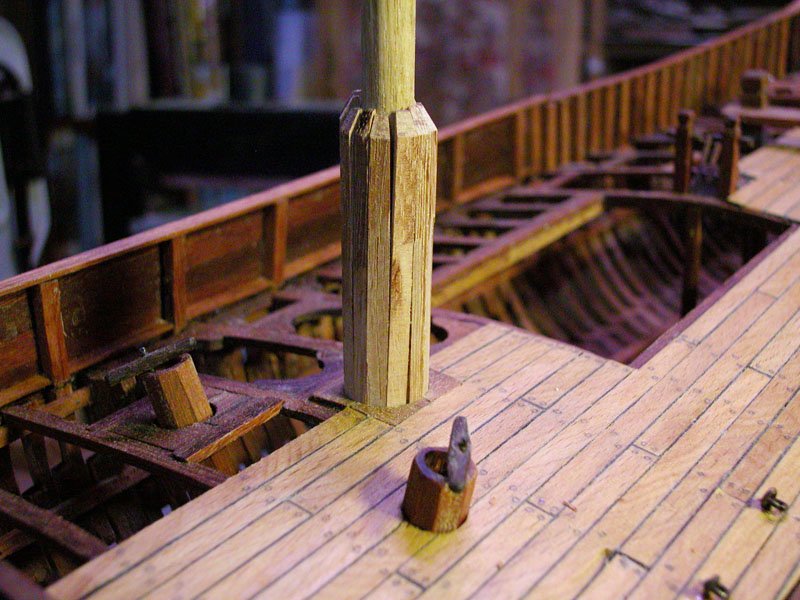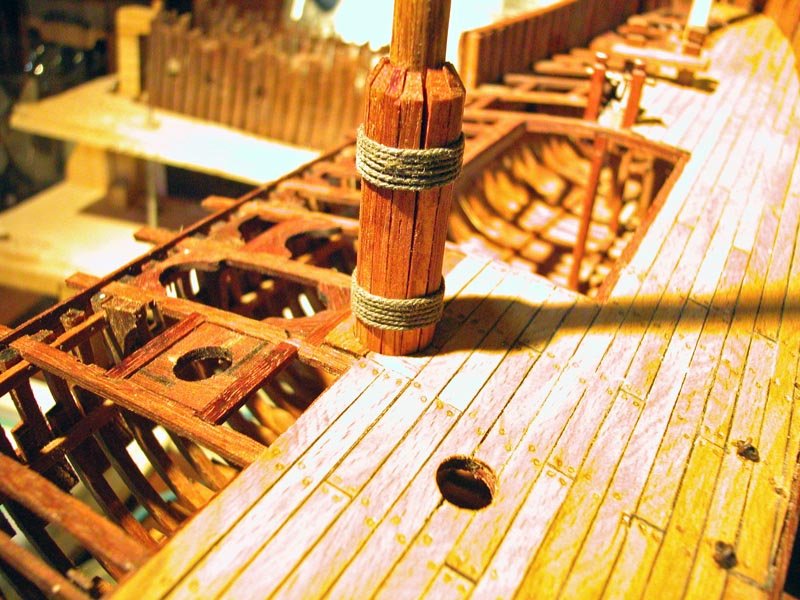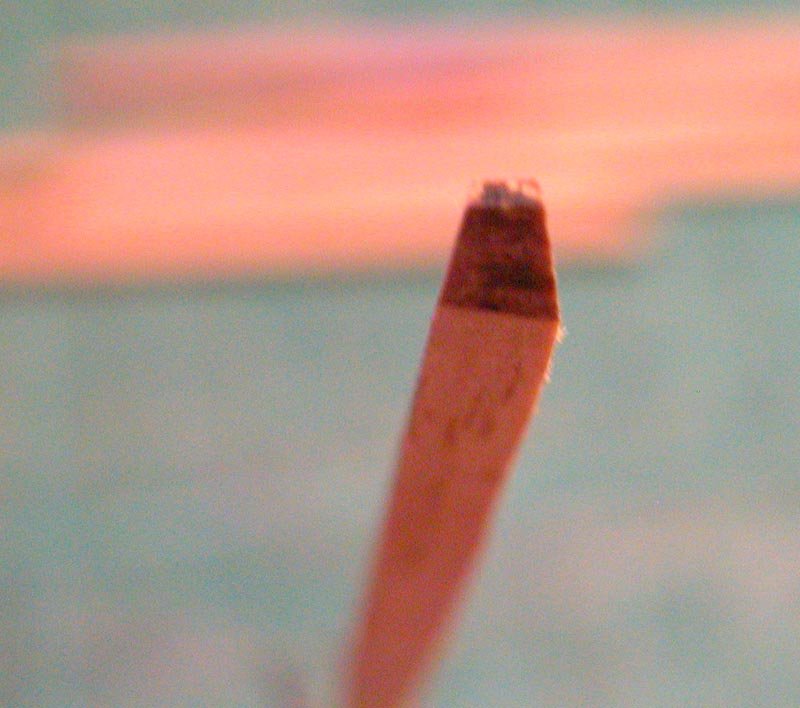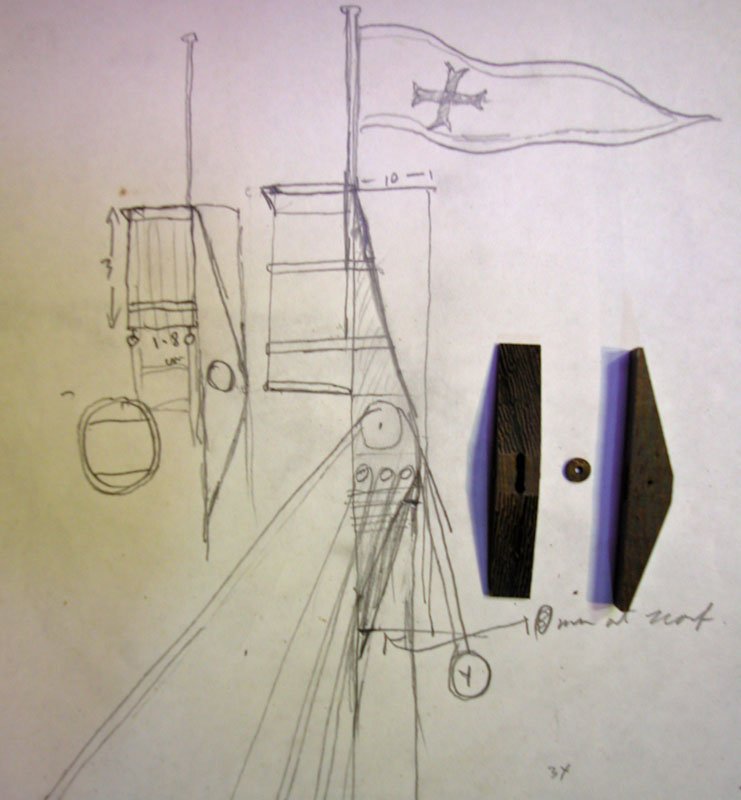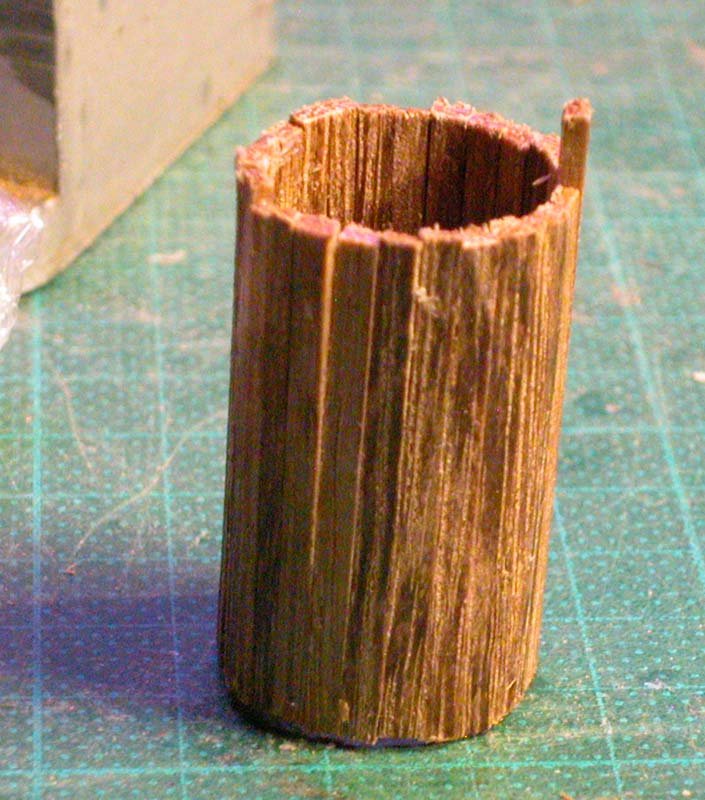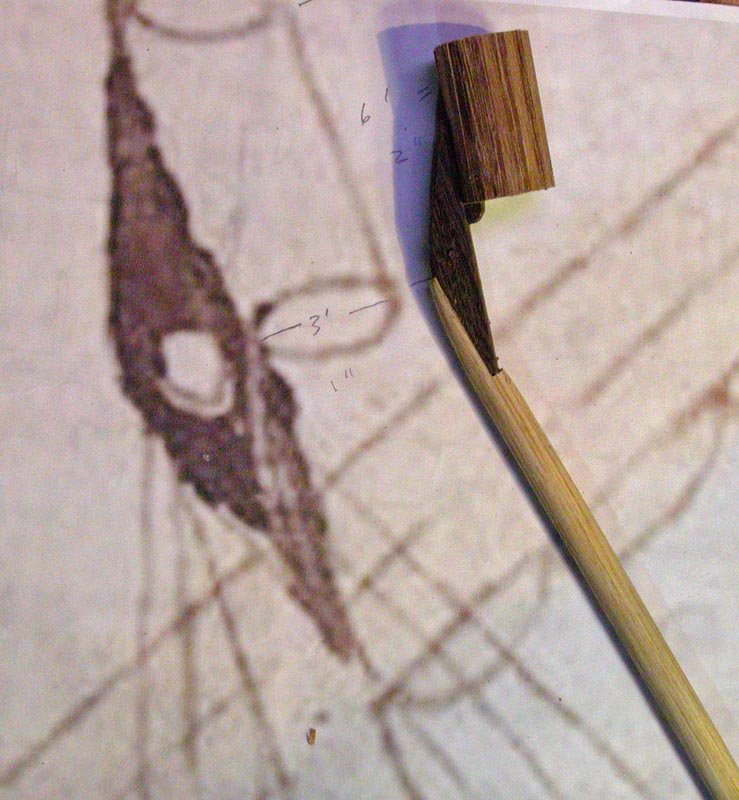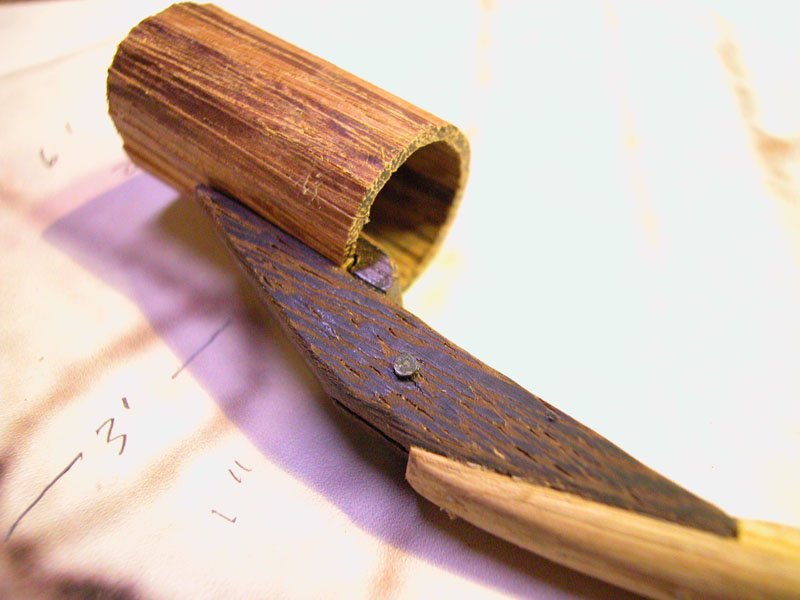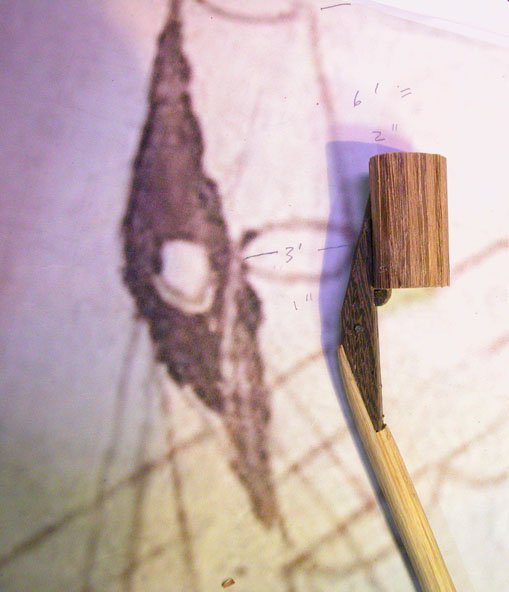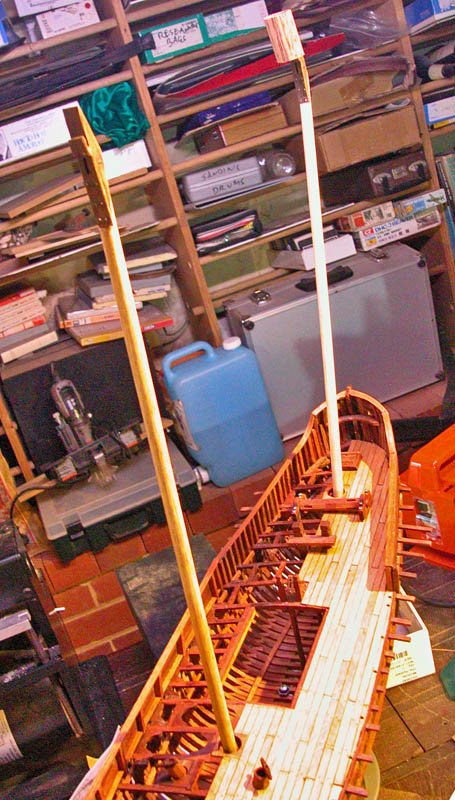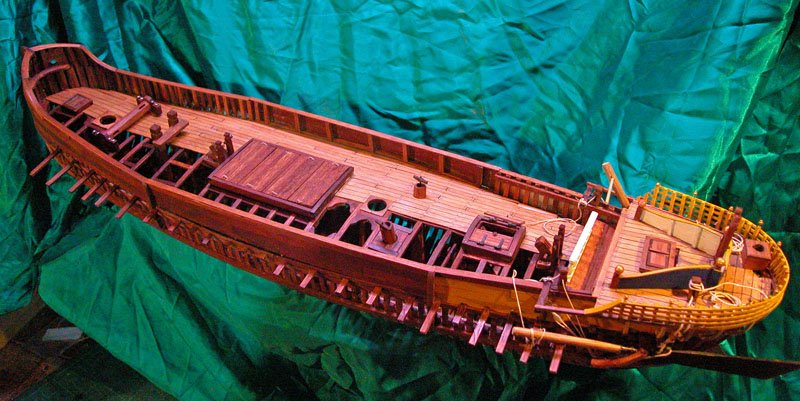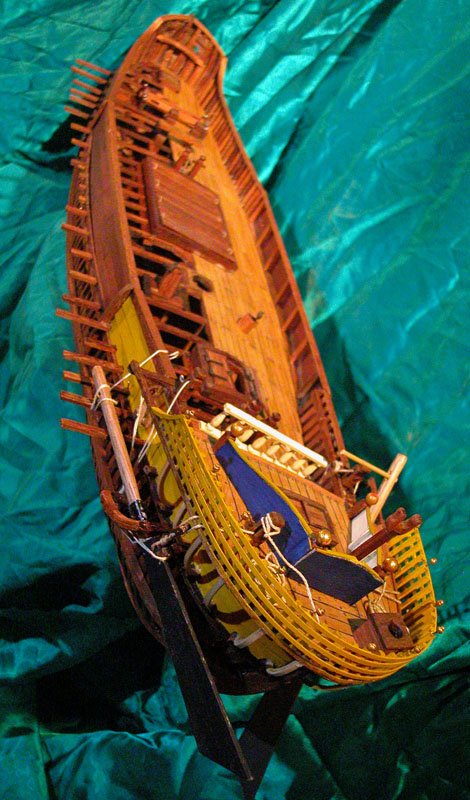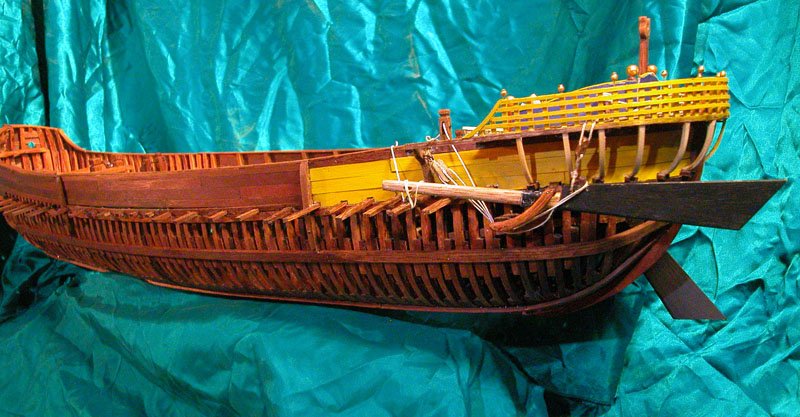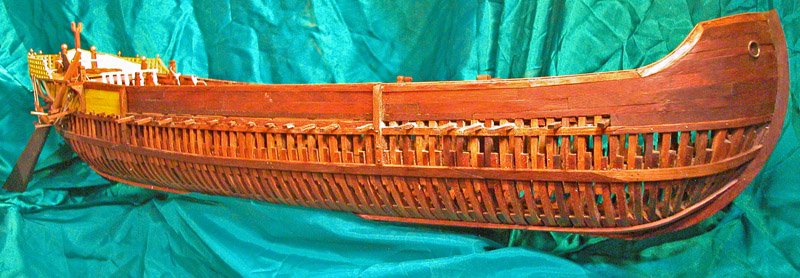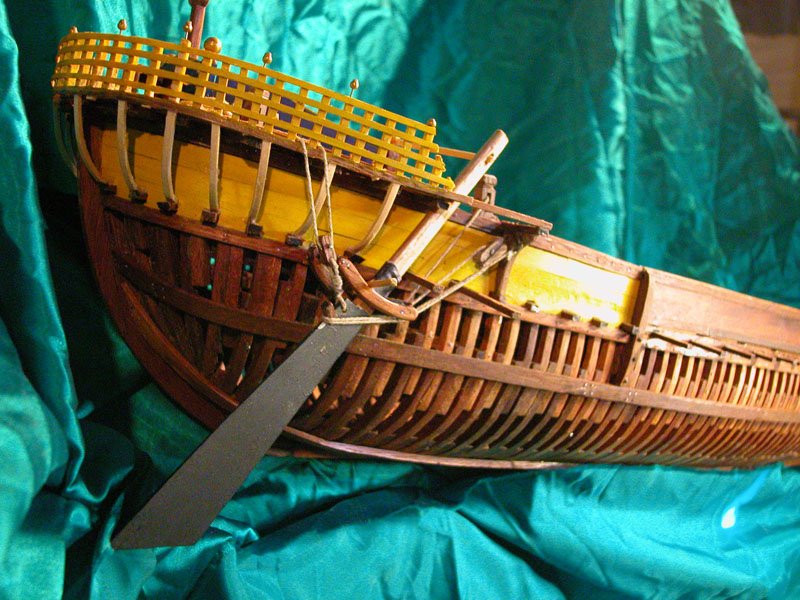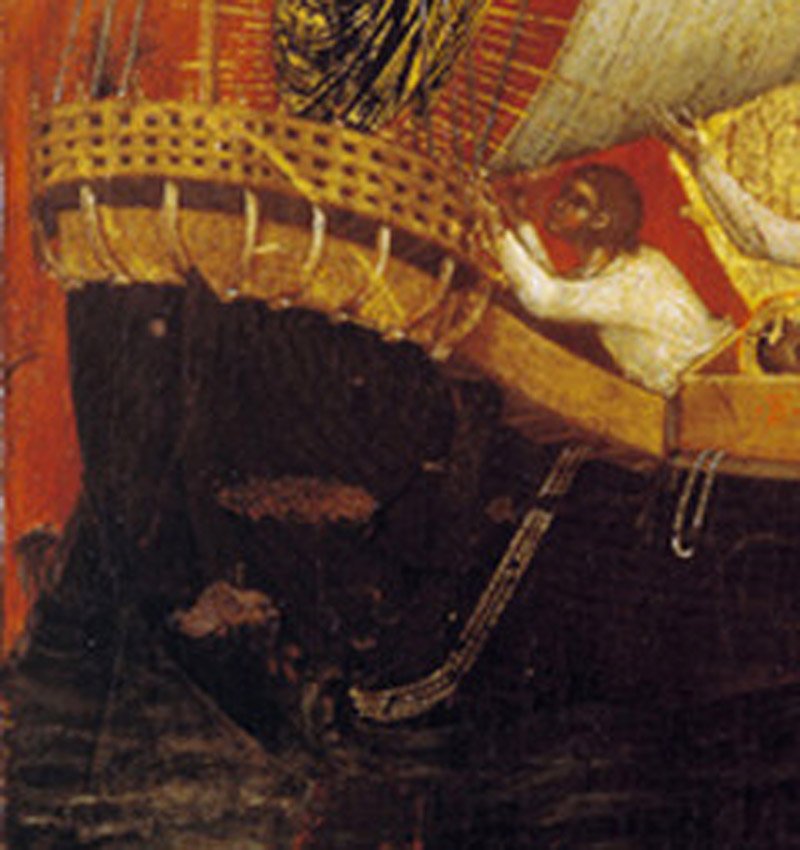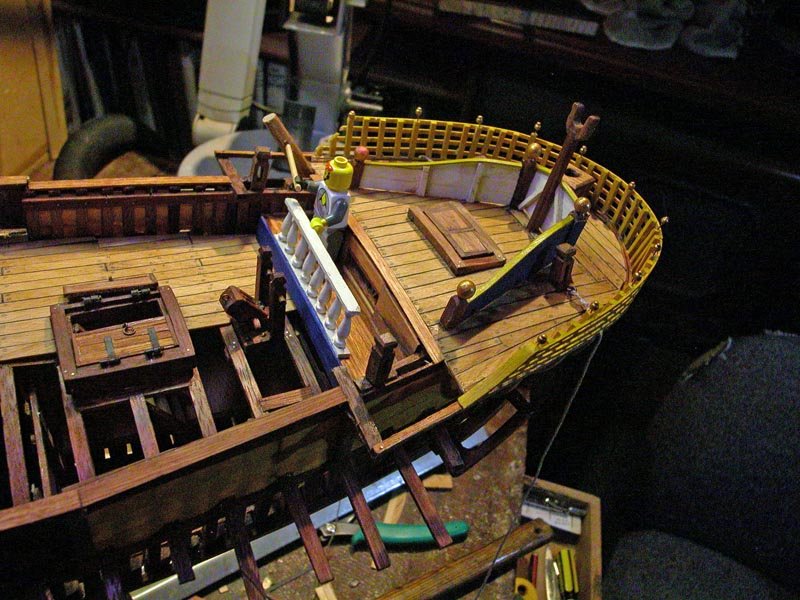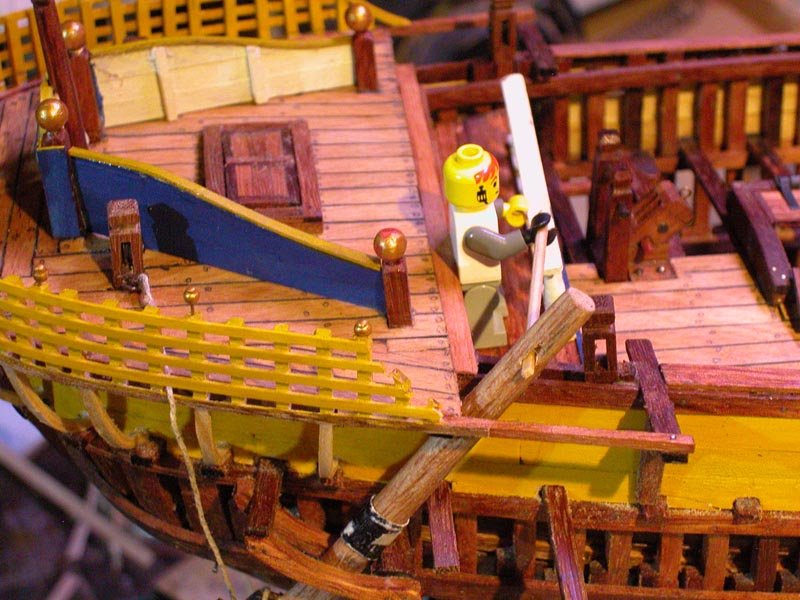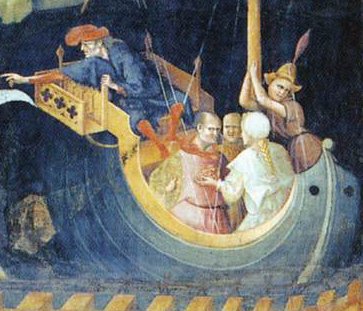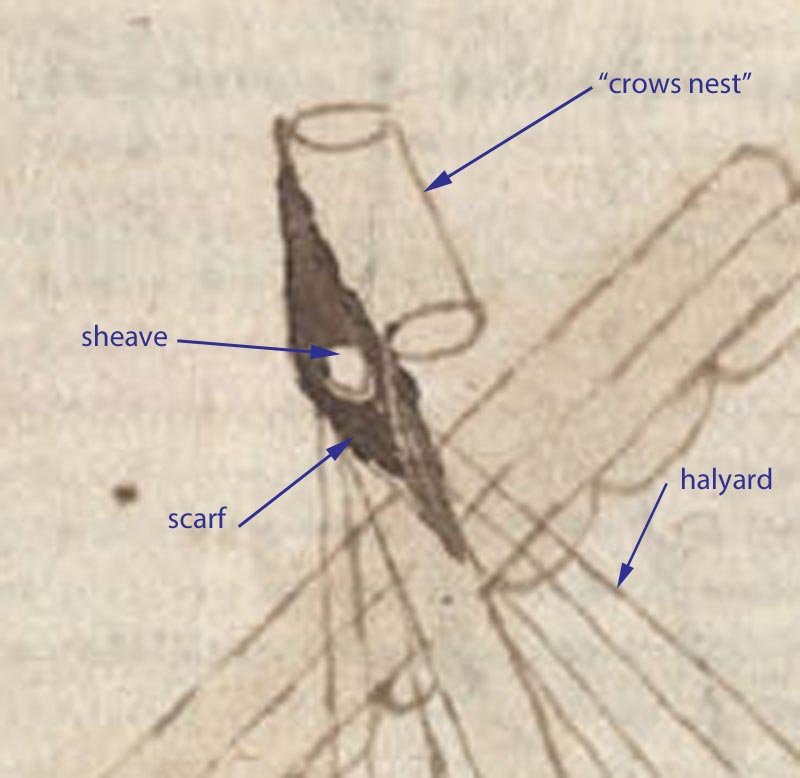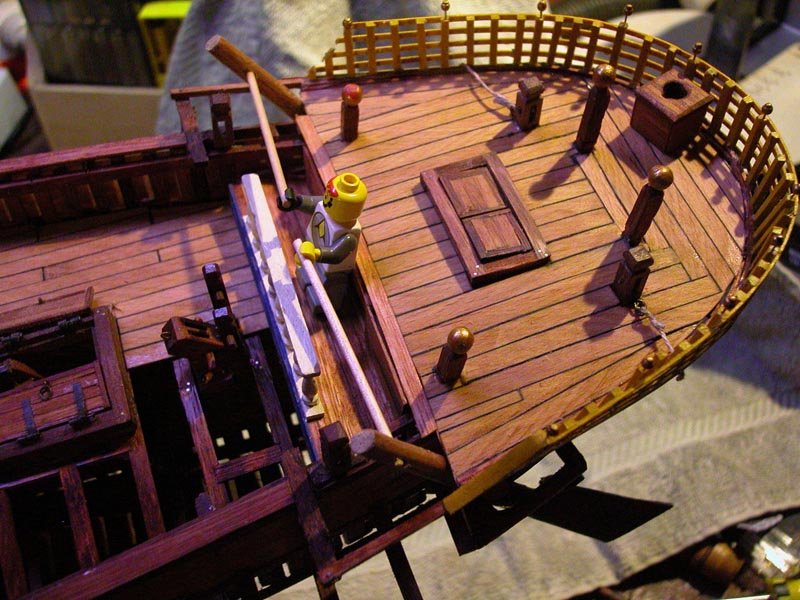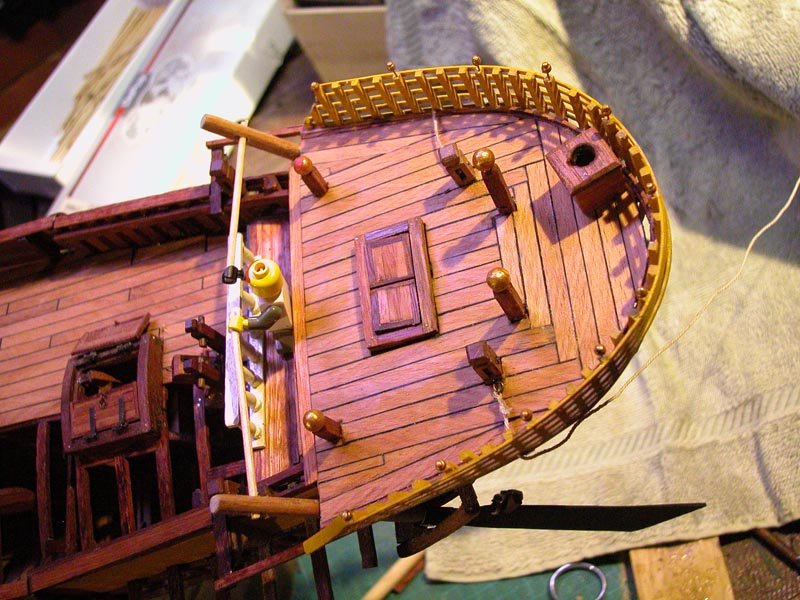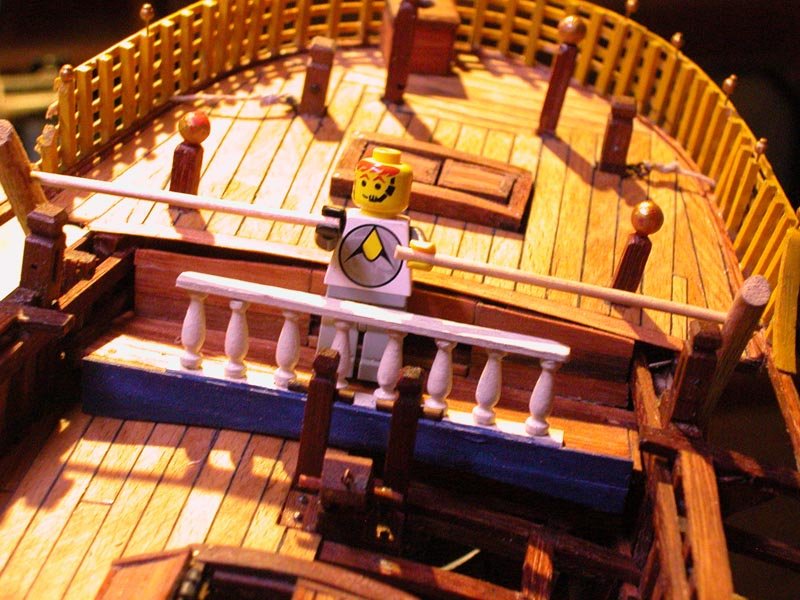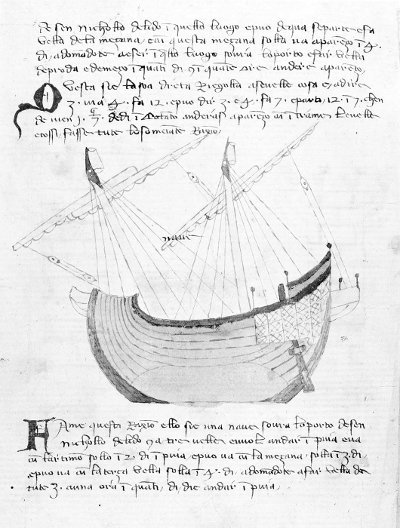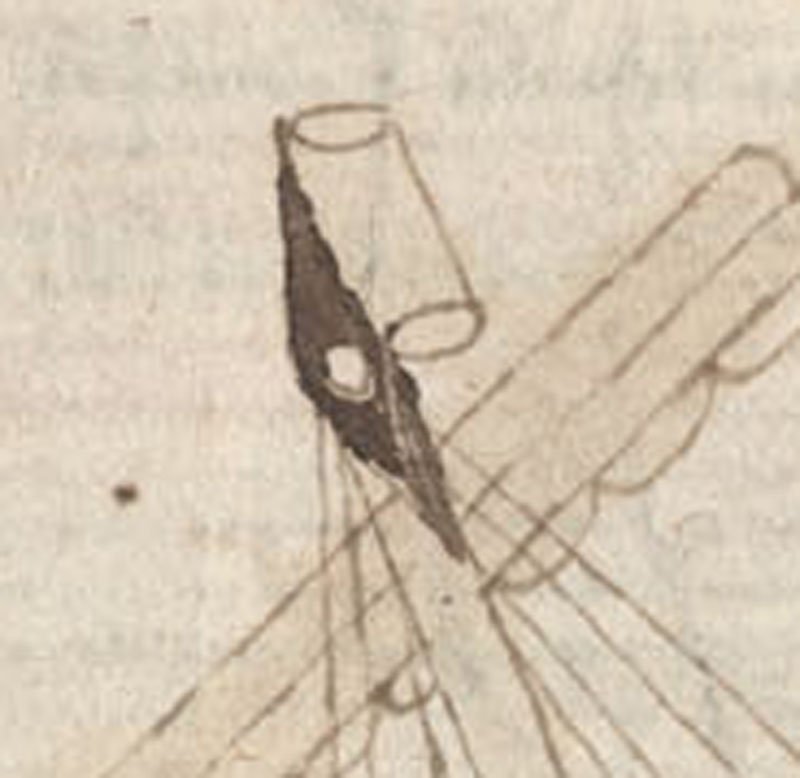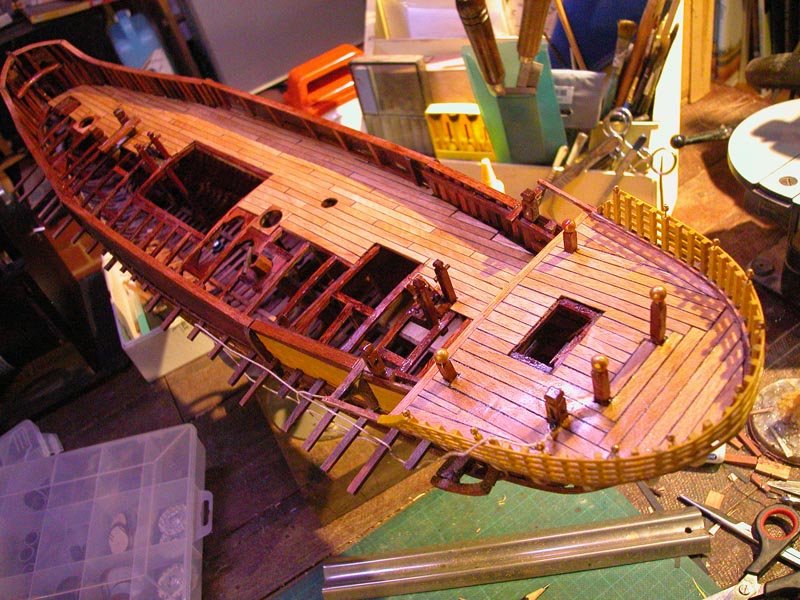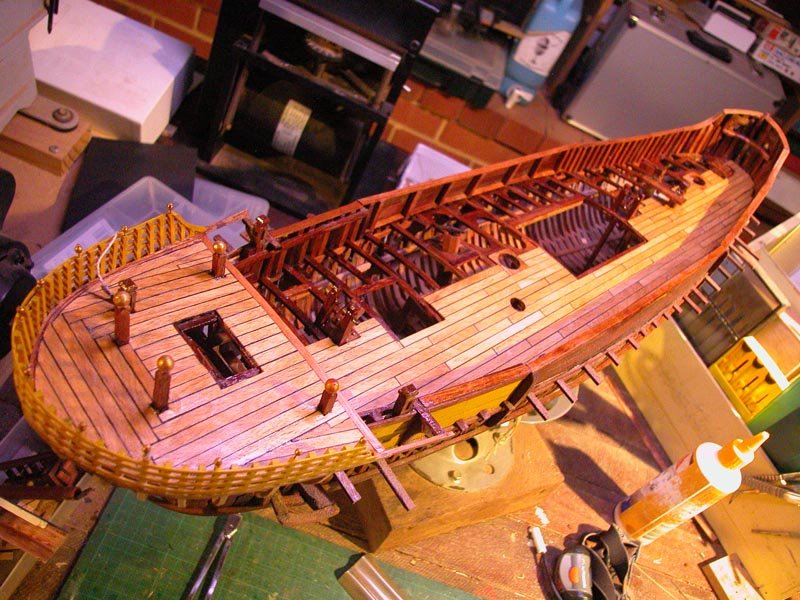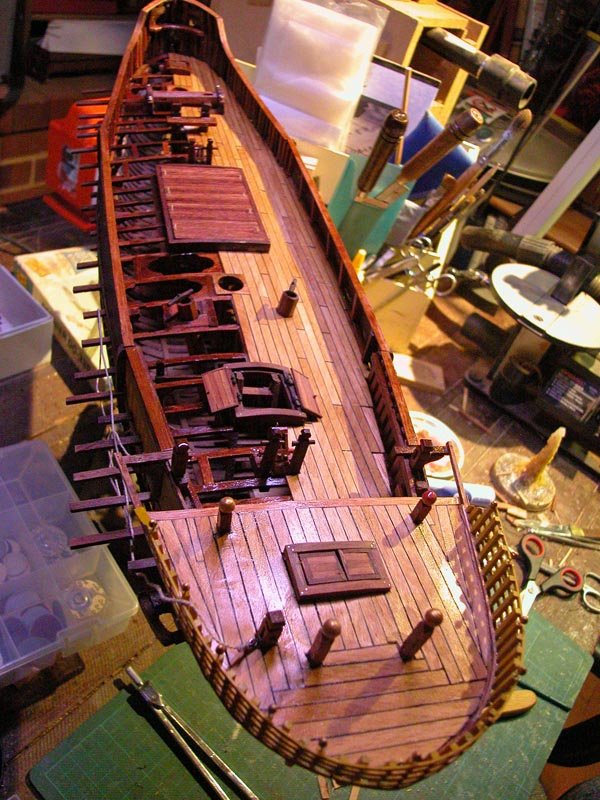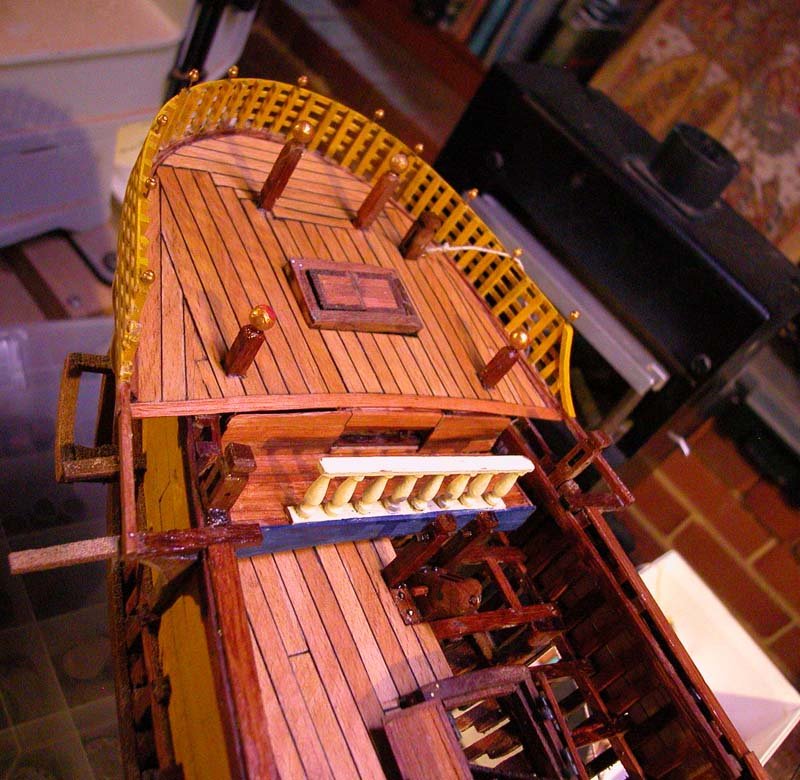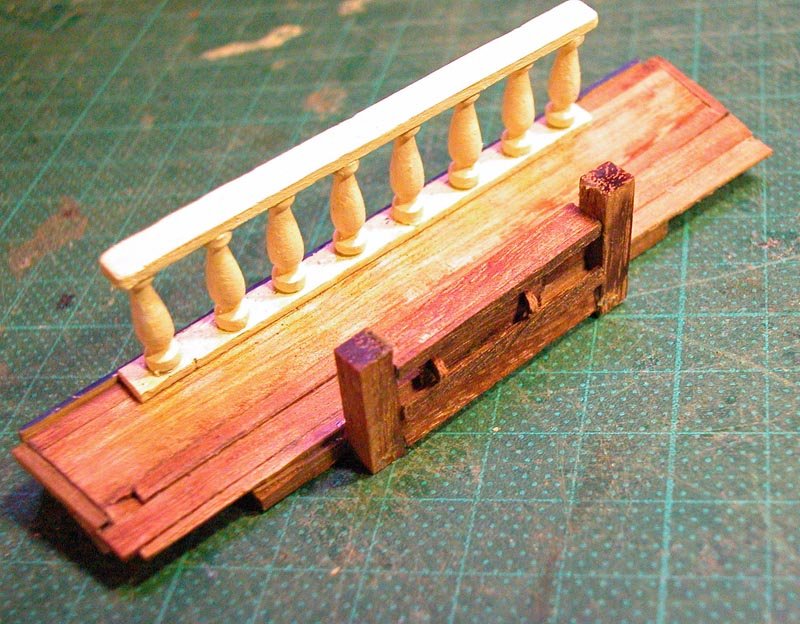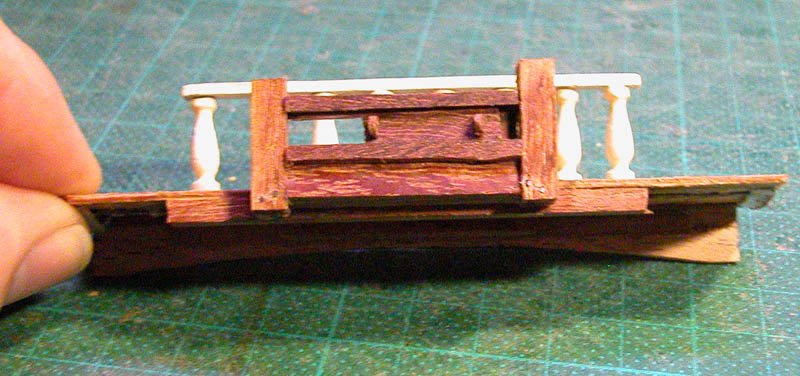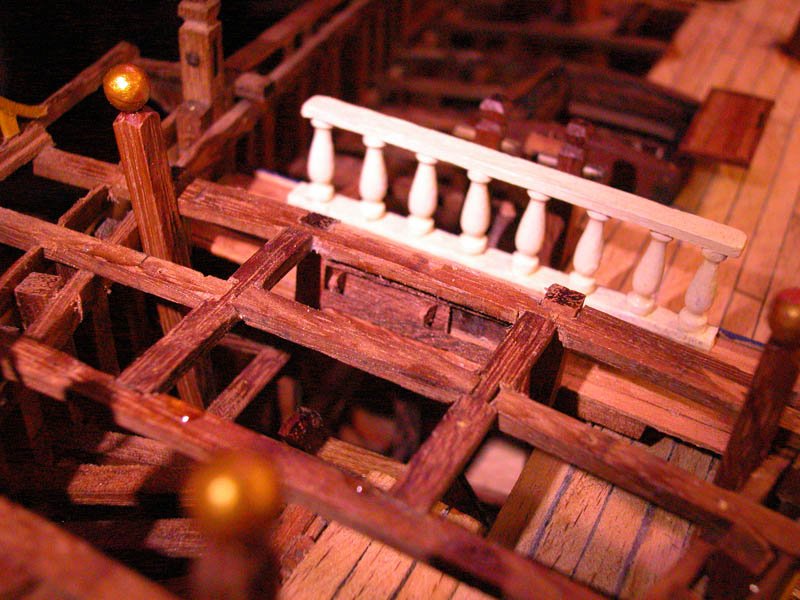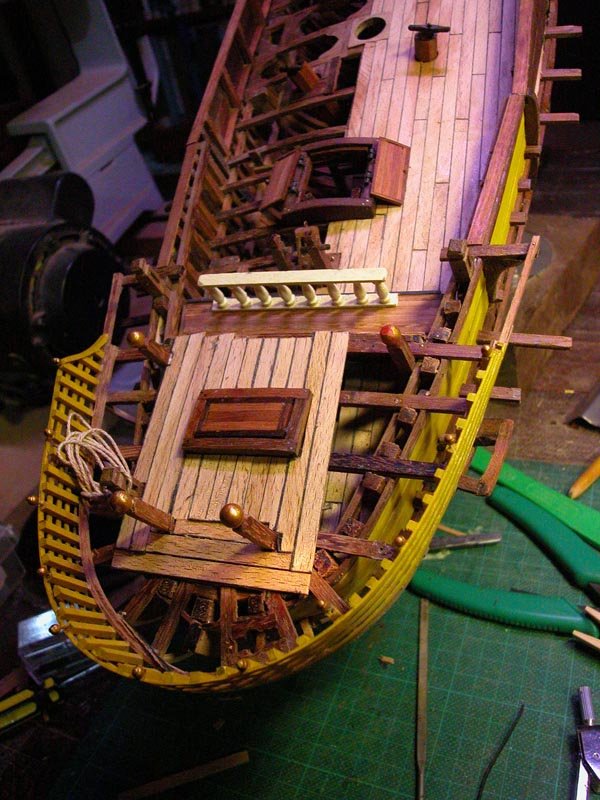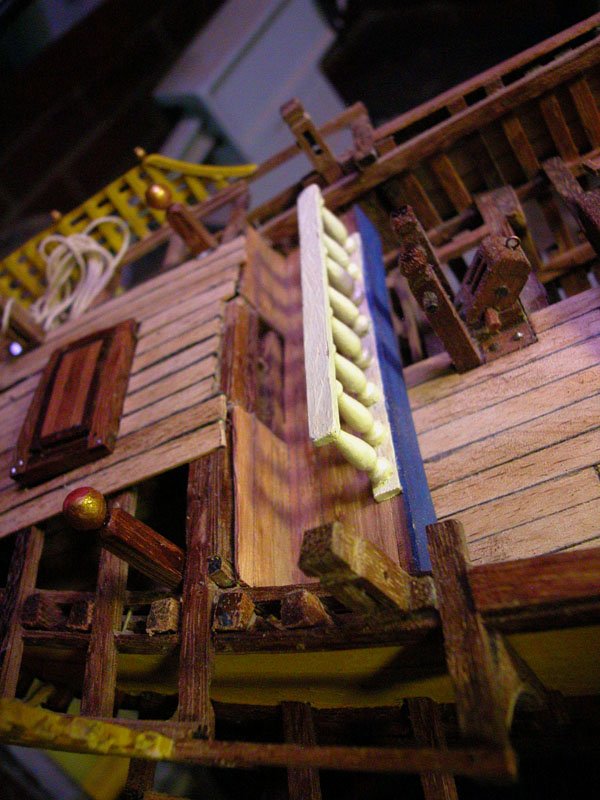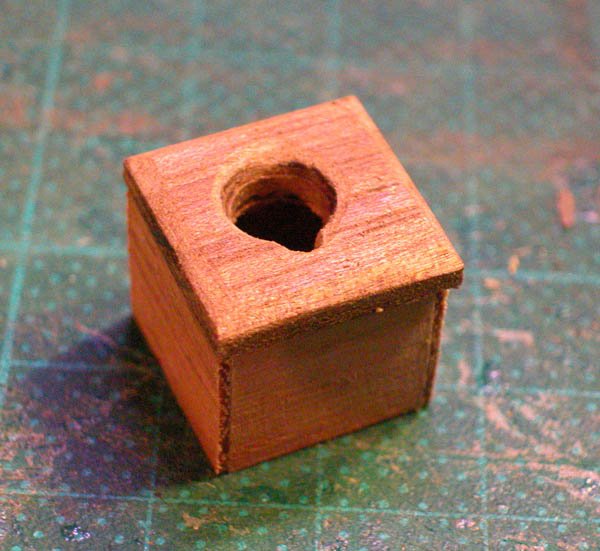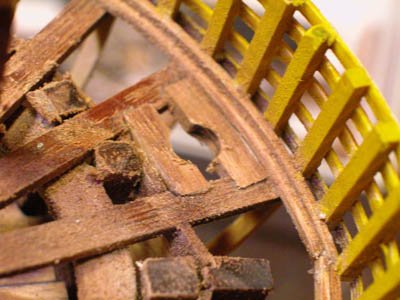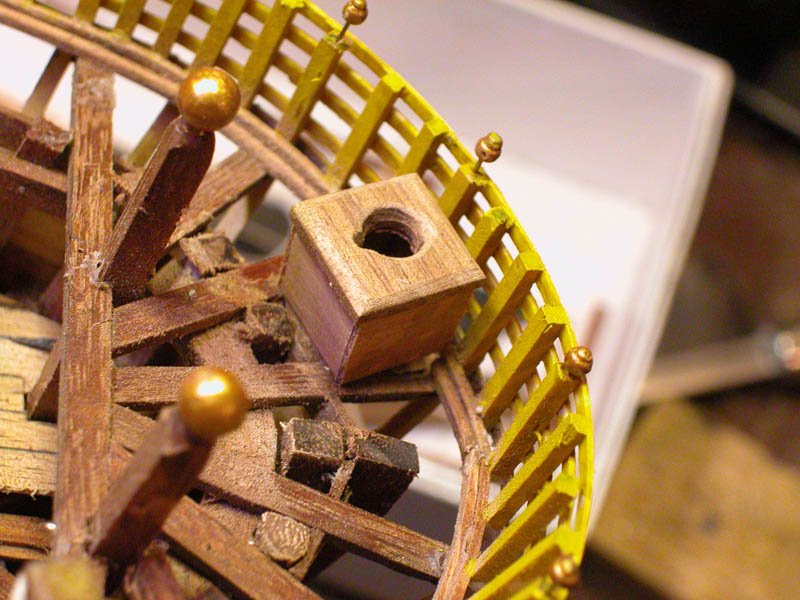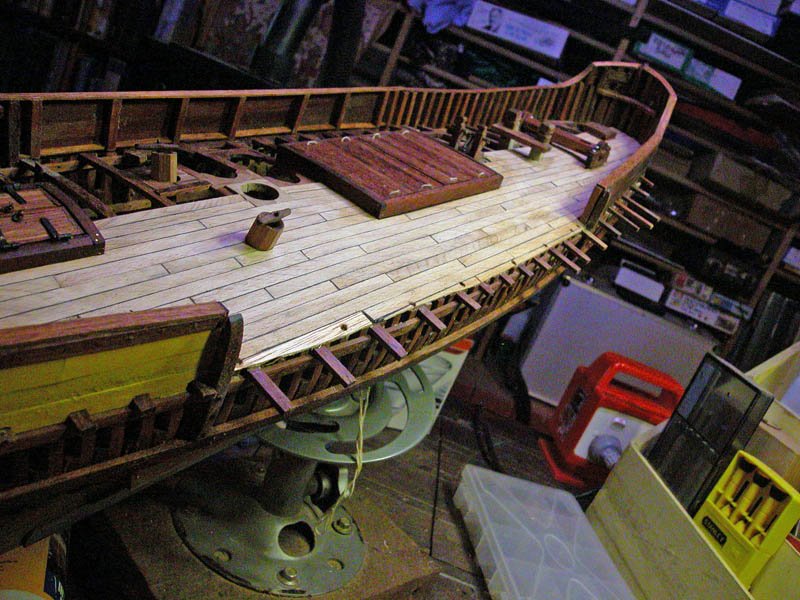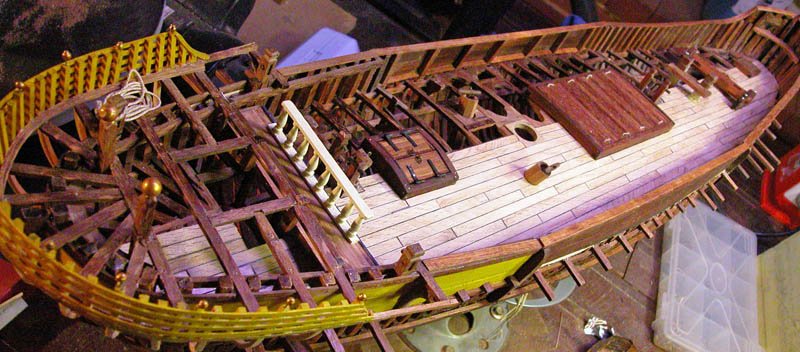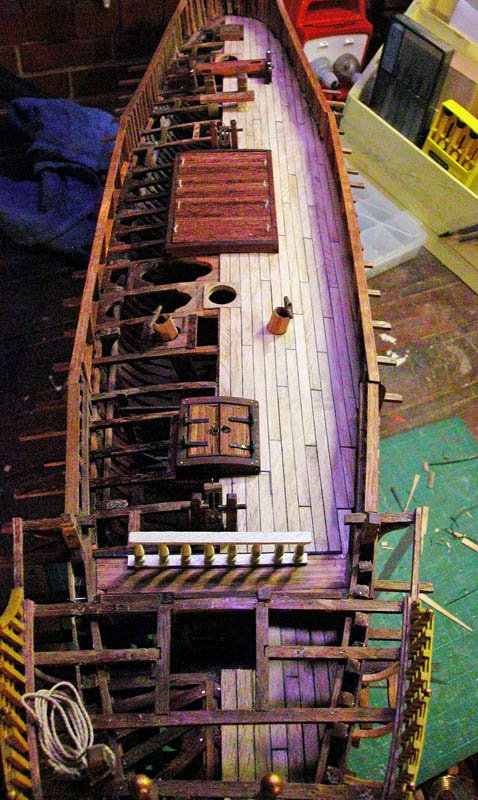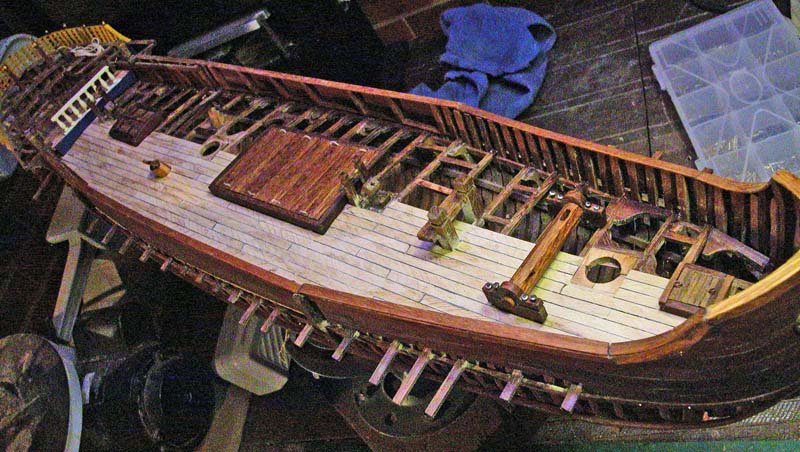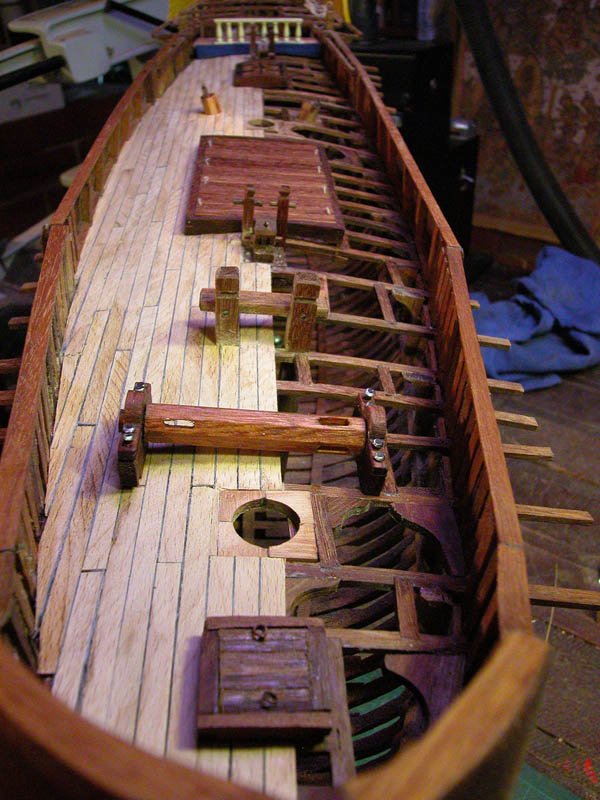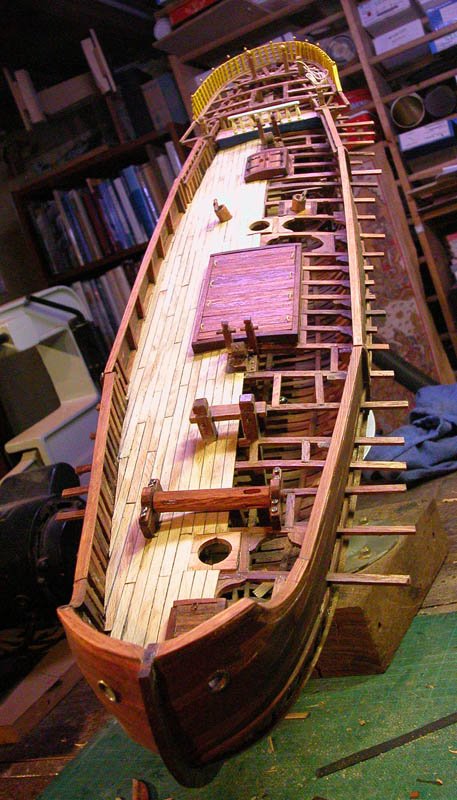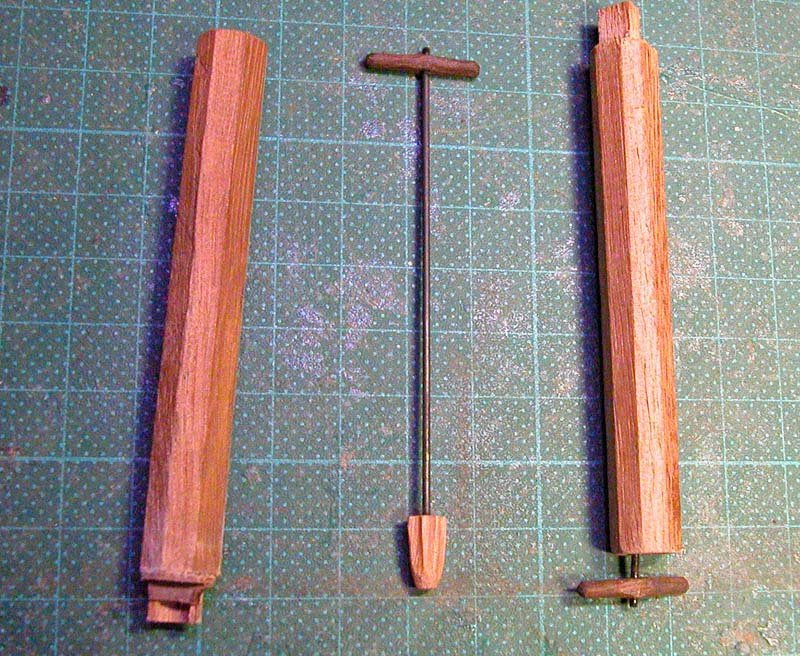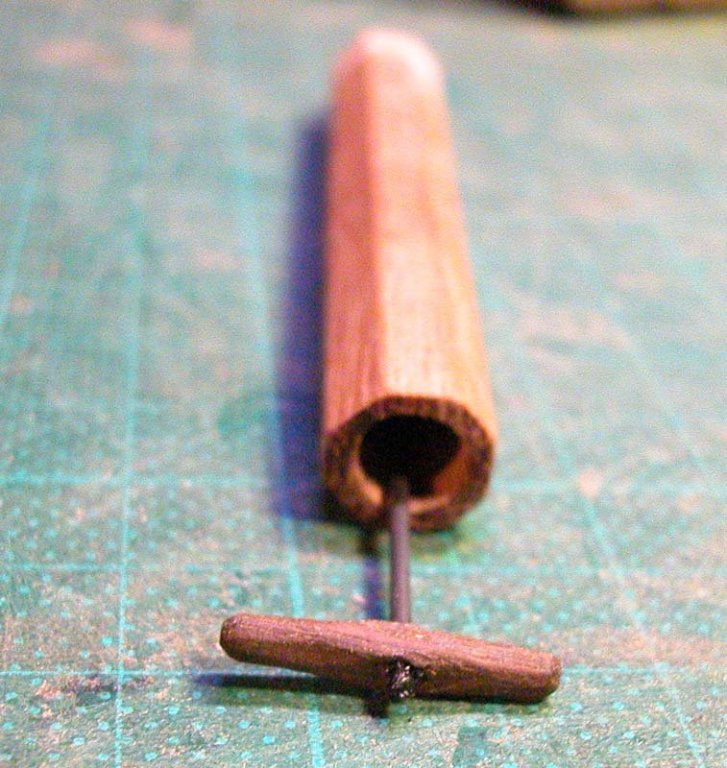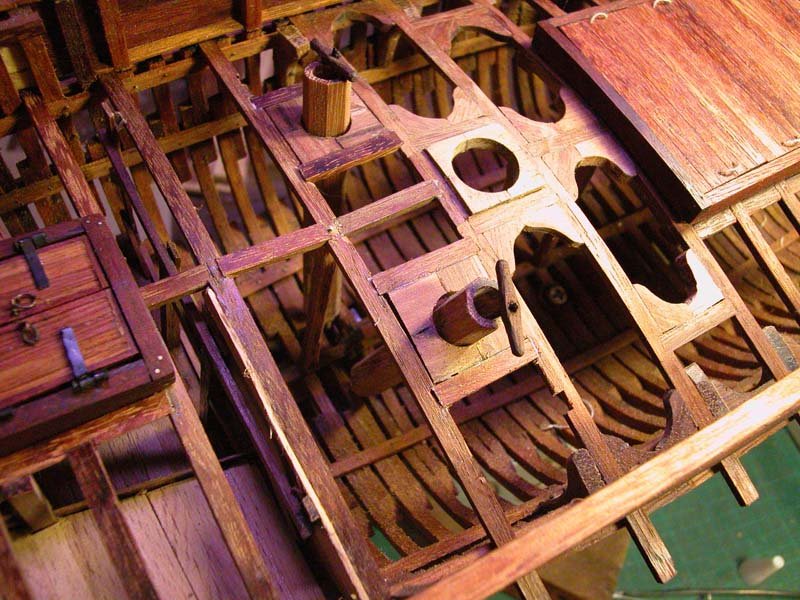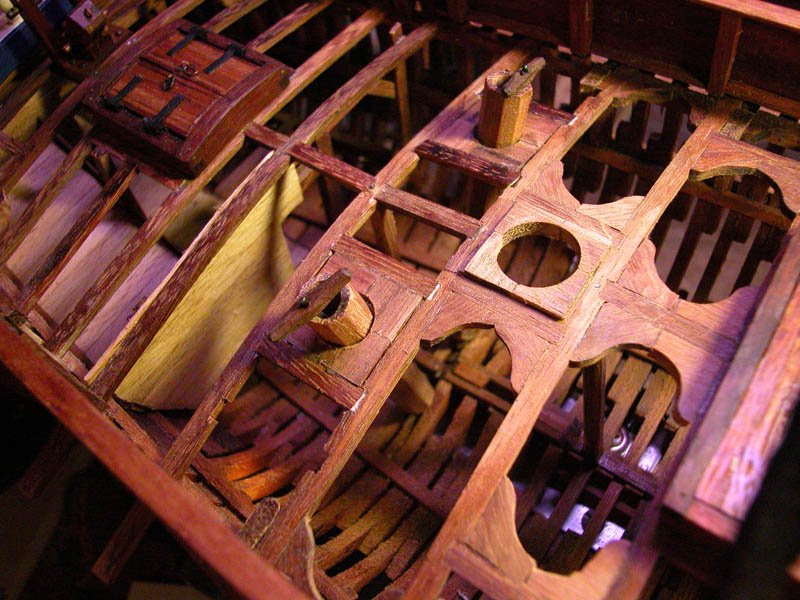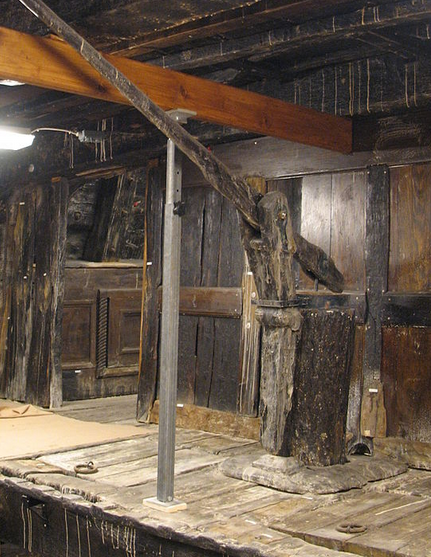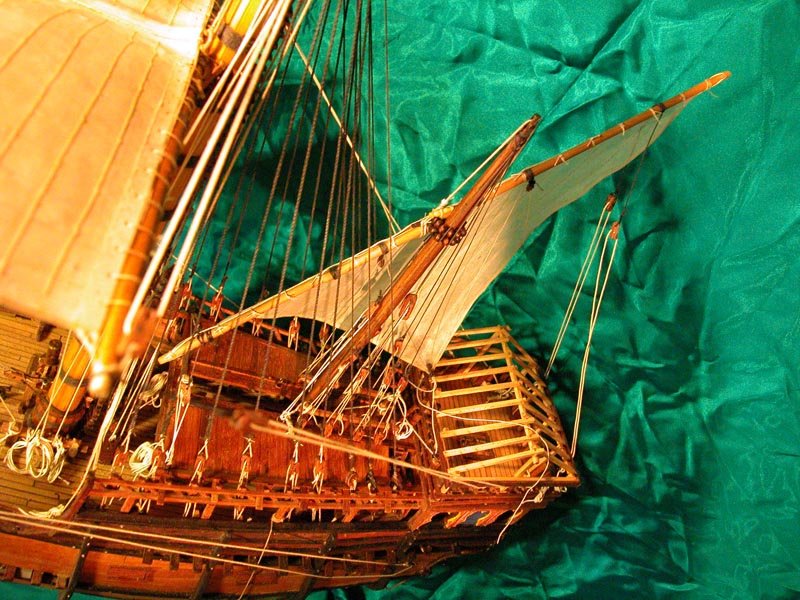-
Posts
834 -
Joined
-
Last visited
Content Type
Profiles
Forums
Gallery
Events
Everything posted by woodrat
-
The shroud rigging. Pendant blocks connected to shroud by toggles. Lower blocks connected to ring bolts on deck. The tackle needs to be able to be rapidly adjusted during tacking. Lee shrouds are kept slack and the weather shrouds taut. Cheers Dick
- 263 replies
-
- nave tonda
- round ship
-
(and 2 more)
Tagged with:
-
Thanks Steven and Lupus Niger. I have been busy making blocks for the shrouds. The mediaeval blocks are somewhat different from those of later centuries . As a model I have used the pulleys from the Mataro nao combined with pulleys seen on Carpaccio's paintings. The double blocks for the shroud pendants are in-line rather than side -by-side. Also the mediaeval blocks were often quite sizeable. Now to make some dozens of toggles.... Merry Xmas Dick🎅
- 263 replies
-
- nave tonda
- round ship
-
(and 2 more)
Tagged with:
-
The mast is stepped. Note that in round ships with latin rig the masts are sloped forward the main (forward) mast more so than the mizzen (after mast). Long staves which are chamfered as are barrel staves are used to wedge the mast into the mast partners. Then the staves are woolded to the mast . Note that these staves project much higher above the deck thean those in later ships such as carracks. Perhaps this is necessary to compensate for the lack of a forestay in latin rig. Cheers Dick
- 263 replies
-
- nave tonda
- round ship
-
(and 2 more)
Tagged with:
-
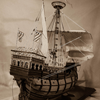
Intellectual property
woodrat replied to woodrat's topic in CAD and 3D Modelling/Drafting Plans with Software
Thanks, Chuck. Very clear Dick -
Just a question for the sea-lawyers out there. If an individual uses a copyrighted book of plans e.eg Anatomy of the ship, and from them constructs a 3D CAD virtual model AND uses this to produce a kit for sale. Does the author of the original book of plans have rights and is the kit producer in breach of IP. Just askin' because there are people using this site who are doing this for profit Dick
-
Thanks, Steven. The following shows the masts. I have estimated that the lengths of the masts is about equal to the length of keel as judged by looking at many pictures. The main (forward) mast is longer than the mizzen (rear) mast but, as the main mast is more tilted forward than the mizzen, the height above deck of the colzexe (calcet) and its attached crows nest is the same in both masts. The following shows the constructof the colzexe to match the Zibaldoni da Canale illustration cheers Dick
- 263 replies
-
- nave tonda
- round ship
-
(and 2 more)
Tagged with:
-
The hull is substantially complete now. The quarter rudders are now shipped. The starboard rudder is in use but the port rudder is not in use and has been retracted using the rudder lift and has been lashed onto one of the through-beams. Cheers Dick
- 263 replies
-
- nave tonda
- round ship
-
(and 2 more)
Tagged with:
-
Thanks for the pic, Steven, great detail in the rigging. Here is a couple of pics of the sternshowing the Lego lad in a more useful position. Note the crutch for the mizzen yard The wooden structure shielding the helmsman is seen in a number of illustrations of round ship. Dick
- 263 replies
-
- nave tonda
- round ship
-
(and 2 more)
Tagged with:
-

Unique 500 year old shipwreck in the Baltic sea
woodrat replied to mic-art's topic in Nautical/Naval History
Go for it, Matie! All you can do is the best you can. Halfway through my build of a round ship C13 a Black Sea wreck of the same era was was found. Fortunately, as I had based my build on solid archaeological evidence and not on speculation, the find largely confirmed my interpretation. In any case there was such a wide variation in local practice that you probably wont go far wrong. Cheers. Dick -
Quite right. This is not the final tiller length. They will be shorter. But in the case of running before the wind, both rudders would be in use, either with two helmsmen or with one in the centre. The contemporary illustrations are not helpful. Also, Lego men's shoulders don't abduct away from the side! Yes but I believe the construction was different in venetian naves to the byzantine hence I am using the venetian name. Dick
- 263 replies
-
- nave tonda
- round ship
-
(and 2 more)
Tagged with:
-
The shape of the module is determined by the forward slope of the mast. This little guy is trying out the tillers for size.
- 263 replies
-
- nave tonda
- round ship
-
(and 2 more)
Tagged with:
-
Thanks. Alberto, I have downloaded the thesis and have started to read it. I have thought about the design of the colzexe (venetian dialect) as shown in contemporary illustrations. This is the wooden module, scarfed to the top of the mast and which contains the halyard block and is the site of attachment of the crows nest. The following illustration from the Zibaldone da Canale document is the best available image and I intend to reproduce this in my model. Dick
- 263 replies
-
- nave tonda
- round ship
-
(and 2 more)
Tagged with:
-
- 263 replies
-
- nave tonda
- round ship
-
(and 2 more)
Tagged with:
-
The steersman's walk. This area is for the steersman or steersmen to stand while managing the tiller(s) of the quarter-rudder(s). Amidship there is an area for seating, below which is the sliding panel to allow instructions to given to the steersman from the after-cabin. Access to the after-cabin is via a scuttle behind the steersman's seat. Dick
- 263 replies
-
- nave tonda
- round ship
-
(and 2 more)
Tagged with:
-
Thanks, Steven. Really enjoying your dromon. I have had a marvellous time making a "thunderbox" for the comfort and convenience of the ship's gentlefolk. As for the crew............well... they can do it some other way, but downwind! Its a lot like the one found on the Bremen cog Here is a pic of the hull with the starboard bulwark removed for cargo access. Dick
- 263 replies
-
- nave tonda
- round ship
-
(and 2 more)
Tagged with:
-
Steven, have you given any thought to modelling the leather sleeves on the lower row of oars which prevent ingress of water? Dick
-
Yes both port and starboard bulwarks are removable in their mid section for loading cargo. This was discovered in the excavation of the Contarina 1 trading vessel. I believe, and this is just supposition on my part, the bulwarks were slid up and then hung outboard on the protruding deck beams. Incidentally, this would allow sweeps to be used on thole pins inserted in the deck. But there are no illustrations of round ships doing this. Dick
- 263 replies
-
- nave tonda
- round ship
-
(and 2 more)
Tagged with:
-
I have planked the starboard side of the main deck only. Waterways and scuppers to be put in next Dick
- 263 replies
-
- nave tonda
- round ship
-
(and 2 more)
Tagged with:
-
Thanks Steven. Beautiful drawings. The sep de drisse (lower halyard block) is in the position seen in carracks, that is behind the main mast and, as it is a large carrack, is vertically extended to the keel . I note that it has two pulleys as does mine. In my round ship, which is a relatively small vessel, I have elected for a more aft placement which is seen on contemporary iconography. As is the case in dhows of comparable size, fixation to deck framing should be enough. Dick
- 263 replies
-
- nave tonda
- round ship
-
(and 2 more)
Tagged with:
-
This block could deal with the halyard. Was there a diagram of the the sep de drisse? Dick
- 263 replies
-
- nave tonda
- round ship
-
(and 2 more)
Tagged with:
-
- 263 replies
-
- nave tonda
- round ship
-
(and 2 more)
Tagged with:
-
Here are the bilge pumps. These were made from single logs (hence their other name: elm tree pumps) which are reamed along their length to accept a simple leather basket . At this period (c 13) the pump was lifted by brute strength but later as in this picture of the Wasa bilge pump, a lever was fitted. Note how the log has been left au naturel and not chamfered as I have done Cheerio Dick
- 263 replies
-
- nave tonda
- round ship
-
(and 2 more)
Tagged with:
-
This is what Michael of Rhodes said in the 15th century. They also could hook up a square sail for running if required. M. Burlet I think is saying there are 2 ropes from the halyard block to the yard. Looks like an interesting book. French is OK Dick
- 263 replies
-
- nave tonda
- round ship
-
(and 2 more)
Tagged with:
-
Fantastic stuff, well researched. Does this imply two upper halyard blocks or one upper halyard block with two halyards leading off it. Could it be that the double pulley A 167 is the upper halyard block? This is a large vessel. This is the mizzen lateen from my venetian carrack showing a calcet with a single sheave Thanks, Steven, food for thought. Dick
- 263 replies
-
- nave tonda
- round ship
-
(and 2 more)
Tagged with:
About us
Modelshipworld - Advancing Ship Modeling through Research
SSL Secured
Your security is important for us so this Website is SSL-Secured
NRG Mailing Address
Nautical Research Guild
237 South Lincoln Street
Westmont IL, 60559-1917
Model Ship World ® and the MSW logo are Registered Trademarks, and belong to the Nautical Research Guild (United States Patent and Trademark Office: No. 6,929,264 & No. 6,929,274, registered Dec. 20, 2022)
Helpful Links
About the NRG
If you enjoy building ship models that are historically accurate as well as beautiful, then The Nautical Research Guild (NRG) is just right for you.
The Guild is a non-profit educational organization whose mission is to “Advance Ship Modeling Through Research”. We provide support to our members in their efforts to raise the quality of their model ships.
The Nautical Research Guild has published our world-renowned quarterly magazine, The Nautical Research Journal, since 1955. The pages of the Journal are full of articles by accomplished ship modelers who show you how they create those exquisite details on their models, and by maritime historians who show you the correct details to build. The Journal is available in both print and digital editions. Go to the NRG web site (www.thenrg.org) to download a complimentary digital copy of the Journal. The NRG also publishes plan sets, books and compilations of back issues of the Journal and the former Ships in Scale and Model Ship Builder magazines.


